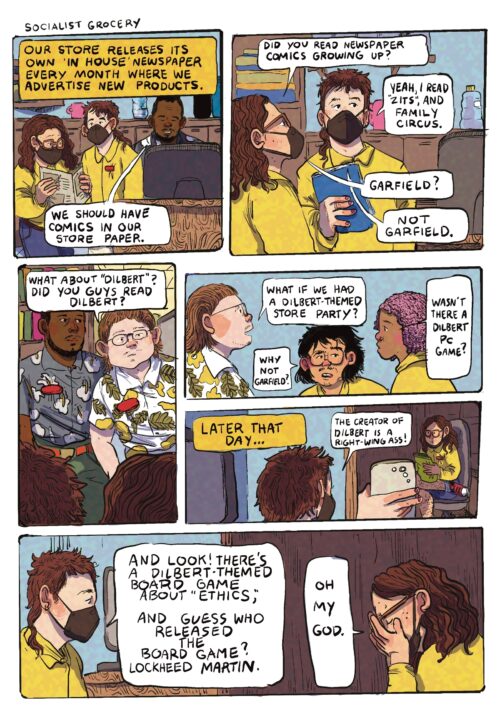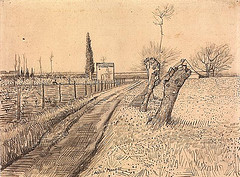
I won’t add a lot to Libby’s great post on the Van Gogh exhibit at the Met, up through Dec. 31. I do want to say a few things. I love the way he saw things. Libby mentioned Van Ruisdael‘s landscapes which were apparently an influence on Van Gogh. But where Van Ruisdael was making pictures — and very pretty ones at that — Van Gogh was reading the land and imposing his soul on it. His depictions of open fields come along again and again, and time after time the artist is caressing the land with his marks, organizing it with strokes of the pen this way and that and willing himself to be there. There’s little distance between himself and what he’s drawing.
(image above is “Path through a Field with Pollard Willows” Mid- to late March 1888, Pen and ink, graphite, with touches of reed pen on wove paper 25.8 x 34.7 cm (10-1/8 x 13-5/8 in.))
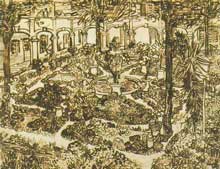
So that when he’s not able to be out in the land that he loved, that is, when he was confined to hospitals for his own safety during his illness his drawings change in response to what he’s seeing and how he’s “in” it. This image is one of the courtyards at the hospital he was in after his breakdown with his ear mutilation. The mark making is dark and the whole thing is claustrophobic and the nature? It’s potted plants and garden landscaping, not the wild rugged farm land he loved.
(above is “The Courtyard of the Hospital in Arles,”First week of May 1889, Reed pen, pen and ink, and graphite on laid paper.)
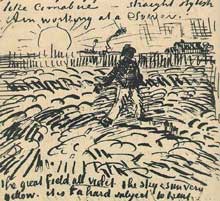
I guess it’s pretty well known that Van Gogh was a great letter writer. His letters back and forth to his brother Theo have been compiled in books and are apparently great reading. But what I didn’t know is that the artist was fluent in English and that he carried on a correspondence in English with an Australian artist, John Russell, whom he met in Paris. The show has a sample of one of the letters and this is a detail of one. (and by the way, all these images are on my flickr site where you can see them larger. And for even more images and information see the Van Gogh Gallery website, which is where I pulled these from). Van Gogh sent Russell many complete drawings in addition to the sketches interwoven in the letters.
(image above is “The Sower,” Sketch in a letter to John Russell, ca. June 17, 1888 [501a] Pen and ink on wove paper 20.3 x 26.3 cm (8 x 10-3/8 in.))
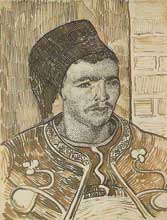
The artist made paintings as well as drawings of course. And sometimes he made drawings based on the paintings, like with this work, the famous Zouave. And he made them as documentary evidence of the paintings, kind of like a snapshot of a work you would take and then send to a friend to say “here’s what I’ve done.”
(above, “The Zouave” (for John Russell) ca. July 31-August 3, 1888, Reed pen, pen, and ink over graphite on wove paper 31.9 x 24.3 cm (12-1/2 x 9-5/8 in.) Signed, lower left: Vincent)
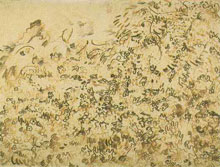
When the artist moved to Arles he started working with a reed pen which he made himself from tall grasses of the area. It’s with the switch to the reed pen that the mark-making gets bolder and more assertive. Of course the tool is crude compared to a crow quill pen and the artist was responding to that but he seems to have found a truly sympatico tool in the object he plucked from the ground around him, whittled into shape and dipped into his ink well.
This image is the last image in the Met exhibit. In the almost abstract work the artist has left off suggesting anything about the land, and here depicts something like the cosmic dust all around. The rhythms of the repeated abstract shapes and lines dance in the air and the whole picture is an internalized thought about connecting with the world.
(image above, “Wild Vegetation,” Late June-July 2, 1889 Reed pen, pen, brush, and ink on wove paper, 47.1 x 62.4 cm (18-1/2 x 24-5/8 in.))
The Met show has several examples of Van Gogh’s paintings interspersed with the drawings. In a way it does the paintings a disservice. He’s such a beautiful draftsman with a fine touch in these drawings. And it makes me think Van Gogh’s pen is mightier than his brush.






